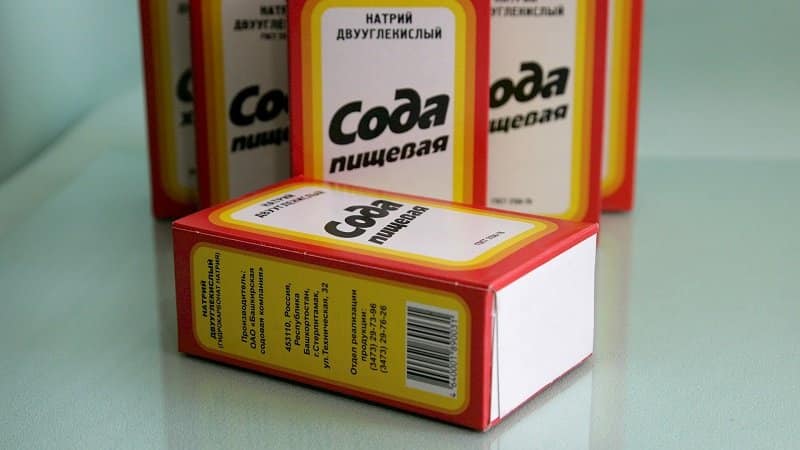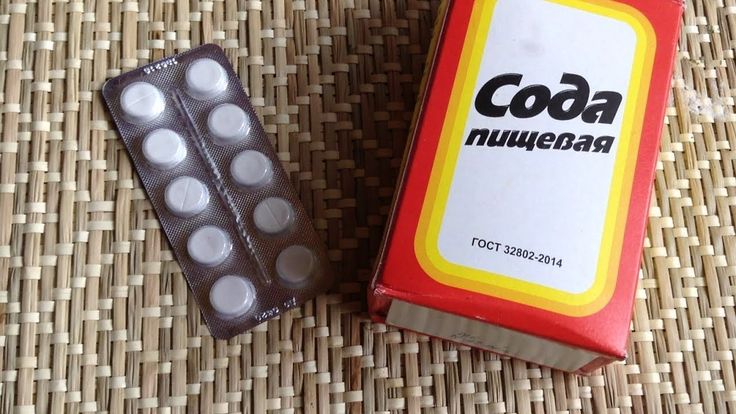How to properly use soda against powdery mildew on gooseberries: recipes and processing recommendations
High humidity and elevated air temperatures favor the appearance of one of the most common and dangerous diseases on gooseberries, called powdery mildew. It is characterized by a light coating with drops of liquid on the foliage and shoots. If the plant is not treated, the fungus affects all branches, the fruits crack and rot. In this article we will tell you how to get rid of powdery mildew on gooseberries using soda.
Why use soda against powdery mildew on gooseberries

Gooseberry is the berry most susceptible to affected by powdery mildew. There are many ways to get rid of the disease, but before buying expensive and harmful chemicals, we advise you to try a time-tested, inexpensive and accessible remedy prepared at home.
Ordinary baking soda, which is found in every home, will help cope with this fungal disease. Another plus of the folk remedy is the possibility of using it in the summer, when the berries are already ripe, while the use of chemicals can destroy crops and harm the human body.
The principle of operation of the product
Baking soda is the simplest soft alkali, and such an environment is destructive for powdery mildew pathogens. Soda is a universal, natural and inexpensive means of combating many plant diseases, available to everyone.
Important! To preserve the healing effect of soda, do not use metal or contaminated containers, and do not heat above +55°C. The solution is used within 3 hours after preparation, otherwise the beneficial effect will decrease. A sprayer with a sprayer may be needed for treatment.
What soda to use
For powdery mildew, use both baking (kitchen) and soda ash (household) soda. The latter is 2 times stronger than food.
Food
Sodium bicarbonate (the scientific name for baking soda) is an alkali that has virtually no effect on plant tissue and does not injure them.
The simplest remedy against powdery mildew is a soda solution. Experienced gardeners get rid of white plaque in 2-3 treatments.

Calcified
Soda ash began to be calcined back in the 19th century. The result was a substance that was not suitable for human consumption, but was widely used in households.
Solutions with soda ash can be used to treat bushes before flowering.
How to prepare the product
Experienced gardeners maintain the following proportions:
- Take 4 liters of water, dissolve 1 tbsp. l. table soda and 1 tsp. liquid soap. The bushes are treated 2-3 times in 7-8 days.
- For 5 liters of water take 25 g of soda ash and 5 g of soap. It is recommended to treat bushes with a cold solution 3 times every 10 days.
Adding soap or other detergent is necessary so that the solution does not flow off the leaves and branches like rainwater, but sticks to the shoots for a stronger and longer-lasting effect.
Recipes
To combat powdery mildew, there are many soda-based recipes.
Baking soda + soap
You need to take:
- baking soda – 4 tbsp. l.;
- liquid soap – 2 tbsp. l.;
- water – 10 l.
Soda and soap are dissolved in water.Gooseberries are treated with this solution every 5-7 days. This composition is suitable for the prevention of diseases of all garden and vegetable crops.
Soda + aspirin

Ingredients:
- baking soda – 1 tbsp. l.;
- aspirin – 1 tablet;
- any detergent - 1 tsp;
- vegetable oil – 1 tbsp. l.;
- water – 5 l.
All ingredients are thoroughly mixed. The solution is applied to the affected plants once every 2 weeks throughout the season.
Soda + iodine
There is another good composition for getting rid of not only ash (powdery mildew), but also aphids.
To prepare it take:
- soda – 2 tbsp. l.;
- iodine – 10 ml;
- liquid soap or other detergent - 2 tbsp. l.;
- water – 10 l.
All ingredients are mixed and diluted with water. The bushes are treated with a freshly prepared solution.
Soda ash + soap
Compound:
- 50 g soda ash;
- 10 liters of water;
- 10 ml liquid detergent.
Soda must be poured into 1 tbsp. boiling water, dilute to obtain a volume of 10 liters. Pour 10 ml of liquid soap into it. The bushes are treated 2 times - before and after flowering.
Important! Although baking soda is considered safe for plants, overdosing should be avoided. Too much can slow down the development of greenery.
How to properly process gooseberries

Processing rules:
- Infected leaves and peduncles (yellow and lacking turgor) are picked off.
- Having discovered powdery mildew on the bushes during the flowering period, you need to cut off the crown and clean the bush from diseased areas. It is necessary to remove infected branches and leaves as much as possible so that the disease does not spread to the rest of the bush. This increases the chances of recovery.
- The top areas of soil from under the gooseberries are removed from the garden plot to avoid re-infestation.
- Then the plant is sprayed with soda solution.The bushes are treated for the first time in early spring - before sap flows and buds open. This is done again at the beginning of flowering. Plants are treated in dry, windless weather. First you need to spray the top of the gooseberry bush, then the sides and bottom. It is necessary that the solution gets on all shoots and foliage. You can pour the medicinal solution into a large basin and immerse the branches of the plant there.
- They also water the ground under the bushes to destroy any remaining spores after replacing the top layer of soil.
When soda powder interacts with metal or plastic, harmful chemical reactions sometimes occur, so it is recommended to use only glass or enamel-coated containers to prepare the solution.
Read also:
Is it possible to water gooseberries and berries with baking soda?
During the fruiting period, the use of chemicals is undesirable. Therefore, to treat gooseberries from powdery mildew, you can use safe solutions of soda ash or baking soda.

Precautionary measures
When treating affected gooseberry bushes, it is important to follow simple rules:
- Wear gloves that protect the skin of your hands from irritation.
- While preparing the solution, it is not recommended to tilt your head over it. Use a mask or various respirators to avoid inhaling components and causing allergic reactions.
- Keep children and animals away from the container with the solution and medications. If liquid gets into the mouth or stomach, rinse immediately. If allergic reactions occur, medical attention is necessary, otherwise swelling of the airways may occur.
- Wash your face and hands with plenty of cold water after completing all work, as well as at the first signs of poisoning or burns. If necessary, call an ambulance immediately.
Efficiency compared to other methods
Treating gooseberry bushes with solutions with soda is one of the most effective and safe methods of combating powdery mildew. If you start treatment when the plant is 30% infected, you can get rid of the disease in 2-3 weeks.
The main condition for success is regularity of procedures. and timely prevention of fungal diseases, which can not only deprive the entire harvest, but also spread to other crops.
Preventive measures
Preventive measures will prevent the development of the disease:
- Shrubs are planted at a distance of 1.5 m in well-lit areas, since the fungus does not tolerate sunlight and heat.
- Gooseberries are systematically thinned out, injured, dried out and diseased branches are regularly cut off.
- Fallen leaves are removed to prevent the spread of fungal diseases.
- Plants are treated with soda solution (2 tablespoons per 8-10 liters of water).
- They loosen the soil next to the bushes, trim the branches or lift them using various devices so that they do not come into contact with the ground.
- It is undesirable to use manure as a fertilizer due to the risk of containing fungal spores.
- Use mineral fertilizers with a minimum nitrogen content. The trace element makes gooseberries more susceptible to fungal diseases.
At the first visible signs of disease, diseased branches and leaves should be removed. This prevents the development of a fungal infection and infection of other plantings. Removed branches are burned, while observing fire safety measures.
Read also:
Conclusion
To protect gooseberries from powdery mildew, prevention is started in the spring. The minimum steps are limited to digging up the area and sanitary pruning of the bushes.
When the first signs of disease are present, plants are treated with a solution of baking soda or soda ash with the addition of soap, iodine or aspirin. This safe and inexpensive remedy will get rid of powdery mildew in 2-3 weeks.